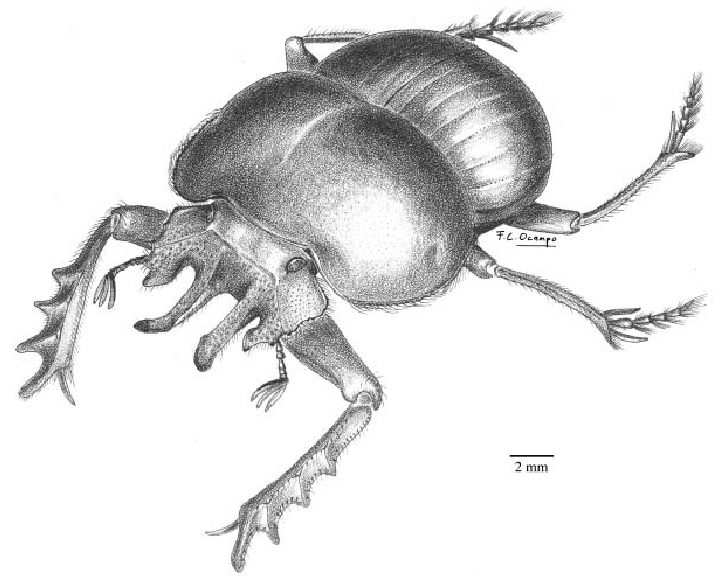 |
|||||||
|
|||||||

Anomiopsoides heteroclyta ( Blanchard).
Illustration by Federico Ocampo.Distribution of Anomiopsoides species.
.
|
||
| Scarabaeinae Taxa Map | ||
| Scarabaeinae
Key |
Diversity and distribution: 5 species. The genus Anomiopsoides is restricted to the Monte biogeographic province in Northwestern Argentina from 26° to 34° S latitude and between 200-1650 m elevation. The climate in this area is temperate-arid with very little rainfall (between 80-250 mm per year). The northern and central regions of the Monte province receive rains in the summer, but in the south it is colder and rainfall is distributed throughout the year.
Diagnosis: The combination of the following characters will separate Anomiopsoides from all other Scarabaeinae in the New World: clypeus with four anterior processes well-developed; pronotum without horns or tubercles; mesocoxae not contiguous at the base; protarsi absent; mesotarsus longer than metatarsus; and hind wings obsolete. The dominant vegetation of this region is scrublands that, at times, can be very open. The landscape consists of sandy plains and plateaus and is characterized by the presence of mountain chains that define several, longitudinal valleys.
Revision or Synopsis: Ocampo, F. C. 2005. Revision of the southern South American endemic genus Anomiopsoides Blackwelder 1944 (Coleoptera: Scarabaeidae: Scarabaeinae: Eucraniini) with description of its food relocation behavior. Journal of Natural History 39: 2537-2557.
Biology: images and videos on the food relocation behavior and natural history of the tribe Eucraniini are available at http://www-museum.unl.edu/research/ entomology/SBSAAL/Eucraniini/project.html.
The behavior and biology of Anomiopsoides species are similar to those of the species of the genus Glyphoderus (Ocampo 2004).
Under natural conditions, the period of surface activity of A. aurita, A. biloba, A. cavifrons, and A. heteroclyta is from 9:30 to 13:00, and from 17:00 to 19:00, depending on the atmospheric and soil temperature. No nocturnal, surface activity was recorded for any species of Anomiopsoides.
All species studied prefer open, sandy or clay soils with a 20-60% vegetation cover. Anomiopsoides species, as most of the Eucraniini, have a specialization for dehydrated dung pellets. Specimens were observed carrying pellets of “cuis chico” (Microcavia australis (Geoffroy Saint-Hilaire & D’Orbigny)), “cuis” (Galea musteloides Meyen), and goat. The use of dung pellets of “vizcacha” (Lagostomus maximus (Desmarest)) by A. heteroclyta was reported by Zunino et al. (1989).
Specimens of A. biloba and A. heteroclyta did not take dry horse or cow dung even when it was offered, and they were not attracted to dung traps baited with fresh human or cow dung. Two species, A. biloba and A. cavifrons, use plant material as food source. Specimens of A. biloba were observed carrying small pieces of dry leaves and seeds (unidentified plant). Two specimens of A. biloba were observed “cutting” small leaves and seeds (that grow at ground level) using their clypeal processes. For that purpose, the beetles placed the leaf or seed in between the medial clypeal processes and pulled out with their head and pronotum. The use of plant material as food source by A. biloba and A. cavifrons was observed occasionally, but plant material does not constitute the main food source of these species.
Populations of Anomiopsoides species occur in isolated areas (usually not larger than 500 m2). Generally, large numbers of individuals of one or two species live in the same area and are commonly associated with rodent nests or goats. The occasional use of plant material by A. biloba and A. cavifrons could be a response to the intra- and interspecific competition observed in the relatively small area of foraging. When foraging, they run on four legs, keeping their forelegs motionless and in a horizontal position with respect to the surface. Adults run in zig-zags or randomly from their burrow (apparently searching for food). To carry the food, the beetles grasp it with the foretibiae and run forward using only their middle and hind legs. This behavior is known only for members of the tribe Eucraniini.
It is not clear how the beetles find their way back to the burrow (along with the shortest possible route). Beetles may use polarized light as a compass bearing that can be used to “calculate” the direction to the burrow. When the entrance of the burrow is reached, the beetles enter by walking forward rather than backward. The burrow of Anomiopsoides is always previously dug. It is variable in depth (usually between 0.20-0.80 m long) and variable in slope (between 35-60° with respect to ground surface). The tunnel may be straight or curved. The depth of the burrow is apparently associated with the depth where the beetle finds a certain level of soil moisture. Burrows are sometimes bifurcated near the end. The beetles store the food at the end of the burrow, and no special chamber is prepared for it. Between 3-8 dung pellets are usually stored, and each pellet is carried independently. Sexual cooperation has been observed, and it follows the same behavior as that observed for individuals. No special brood chambers were observed in burrows constructed by pairs. During the hours where there is no surface activity, it is common to observe the entrance of the burrow obscured with sand or other substrate.
|
||||
|
|
